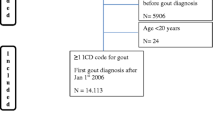Abstract
To examine the management of gout in general practice in Townsville, Australia, and to explore comorbid conditions in patients with gout. Study will also explore how closely guidelines are being followed in managing gout. Retrospective chart review was conducted from May to November 2014 in three general practices in Townsville. Registers for patients were established by searching “gout” and “gouty arthritis”. Three hundred and twenty-one patients were included in the study after excluding inactive patients, patients below age of 18 and patients with cancer. Main outcome measures were prevalence of comorbidities in gout patients, gout medications and adequate serum urate control (≤0.36 mmol/l). Multivariate logistic regression was used to study the relationship between serum urate level, comorbid conditions and lifestyle factors. Hypertension was the most common comorbid condition with 60.8 % of patients followed by obesity and dyslipidaemia. In terms of medication, 46.7 % of patients were on allopurinol, 12.8 % on indomethacin and 13.4 % on diuretics. Eighty-six percentage of patients had serum urate level (sUA) recorded in the previous year. Of these, 32.2 % had a serum urate level below or equal to 0.36 mmol/l. Moreover, 17.4 % of patients had lifestyle advice documented in chart. Male gender was the most influential factor in having poor uric acid control (p < 0.01), followed by not being on allopurinol (p < 0.01) and patients older than 50 years (p = 0.02). Management of gout in this study sample was not entirely concordant with guidelines. The study also suggests a need for possible tighter monitoring and allopurinol dosing regime in older, male patients.

Similar content being viewed by others
References
Arromdee E, Michet CJ, Crowson CS, O’Fallon WM, Gabriel SE (2002) Epidemiology of gout: Is the incidence rising? J Rheum 29(11):2403–2406
Robinson PC, Taylor WJ, Merriman TR (2012) Systematic review of the prevalence of gout and hyperuricemia in Australia. Int Med J 42(9):997–1007
Owens D, Whelan B, McCarthy G (2008) A survey of the management of gout in primary care. Irish Med J 101(5):147–149
Terkeltaub R (2010) Update on gout: new therapeutic strategies and options. Nat Rev Rheumatol 6(1):30–38
Roddy E, Mallen CD, Hider SL, Jordan KP (2010) Prescription and comorbidity screening following consultation for acute gout in primary care. Rheumatology 49(1):105–111
Zhang W, Doherty M, Bardin T, Pascual E, Barskova V, Conaghan P et al (2006) EULAR evidence based recommendations for gout. Part II: management. Report of a task force of the EULAR standing committee for international clinical studies including therapeutics (ESCISIT). Ann Rheum Dis 65(10):1312–1324
Jeyaruban A, Larkins S, Soden M (2015) Management of gout in general practice—a systematic review. Clin Rheumatol 34(1):9–16
Cottrell E, Crabtree V, Edwards JJ, Roddy E (2013) Improvement in the management of gout is vital and overdue: an audit from a UK primary care medical practice. BMC Fam Pract 14:170
Annemans L, Spaepen E, Gaskin M, Bonnemaire M, Malier V, Gilbert T et al (2008) Gout in the UK and Germany: prevalence, comorbidities and management in general practice 2000–2005. Ann Rheum Dis 67(7):960–966
Singh JA, Hodges JS, Toscano JP, Asch SM (2007) Quality of care for gout in the US needs improvement. Arthritis Rheum 57(5):822–829
Australian Bureau of Statistics. Australian system of national accounts. ABS 2011
Corp I (2014) IBM SPSS Statistics for Windows 23.0 ed. IBM Corp, Armonk, New York
Australian Government: National Health and Medical Research Council (2009) Australian guidelines to reduce health risks from drinking alcohol
Choi HK, Ford ES, Li C, Curhan G (2007) Prevalence of the metabolic syndrome in patients with gout: the third national health and nutrition examination survey. Arthritis Rheum 57(1):109–115
Krishnan E, Baker JF, Furst DE, Schumacher HR (2006) Gout and the risk of acute myocardial infarction. Arthritis Rheum 54(8):2688–2696
Roddy E, Zhang W, Doherty M (2007) Concordance of the management of chronic gout in a UK primary-care population with the EULAR gout recommendations. Ann Rheum Dis 66(10):1311–1315
Jeyaruban A, Soden M, Larkins S (2016) General practitioners’ perspectives on the management of gout: a qualitative study. Postgrad Med J 92(1092):603–607
Harrold LR, Yood RA, Mikuls TR, Andrade SE, Davis J, Fuller J et al (2006) Sex differences in gout epidemiology: evaluation and treatment. Ann Rheum Dis 65(10):1368–1372
Choi HK, Mount DB, Reginato AM (2005) American College of P, American Physiological S. Pathogenesis of gout. Ann Intern Med 143(7):499–516
Sarawate CA, Patel PA, Schumacher HR, Yang W, Brewer KK, Bakst AW (2006) Serum urate levels and gout flares: analysis from managed care data. J Clin Rheumatol Pract Rep Rheum Musculoskel Dis 12(2):61–65
(2010) Therapeutic guidelines: rheumatology (2010) 3rd edn. Oxford University press, Gout. http://www.tg.org.au
Acknowledgments
I would like to thank the practice managers of the three general practices and James Cook University for funding the project and assisting with the development of the project.
Funding
The project was funded by the James Cook University Honours fund.
Author information
Authors and Affiliations
Corresponding author
Ethics declarations
Conflict of interest
Andrew Jeyaruban declares that he has no conflict of interest. Muriel Soden declares that she has no conflict of interest. Sarah Larkins declares that she has no conflict of interest.
Human participants or animals consent
This article does not contain any studies with human participants or animals performed by any of the authors.
Informed consent
Informed consent was obtained from the practice managers for the project. Project was approved by James Cook University Ethics Committee (Approval number = H5601).
Rights and permissions
About this article
Cite this article
Jeyaruban, A., Soden, M. & Larkins, S. Prevalence of comorbidities and management of gout in a tropical city in Australia. Rheumatol Int 36, 1753–1758 (2016). https://doi.org/10.1007/s00296-016-3580-6
Received:
Accepted:
Published:
Issue Date:
DOI: https://doi.org/10.1007/s00296-016-3580-6




